


Microsoft Corp. today released software updates to quash 130 security bugs in its Windows operating systems and related software, including at least five flaws that are already seeing active exploitation. Meanwhile, Apple customers have their own zero-day woes again this month: On Monday, Apple issued (and then quickly pulled) an emergency update to fix a zero-day vulnerability that is being exploited on MacOS and iOS devices.

On July 10, Apple pushed a “Rapid Security Response” update to fix a code execution flaw in the Webkit browser component built into iOS, iPadOS, and macOS Ventura. Almost as soon as the patch went out, Apple pulled the software because it was reportedly causing problems loading certain websites. MacRumors says Apple will likely re-release the patches when the glitches have been addressed.
Launched in May, Apple’s Rapid Security Response updates are designed to address time-sensitive vulnerabilities, and this is the second month Apple has used it. July marks the sixth month this year that Apple has released updates for zero-day vulnerabilities — those that get exploited by malware or malcontents before there is an official patch available.
If you rely on Apple devices and don’t have automatic updates enabled, please take a moment to check the patch status of your various iDevices. The latest security update that includes the fix for the zero-day bug should be available in iOS/iPadOS 16.5.1, macOS 13.4.1, and Safari 16.5.2.
On the Windows side, there are at least four vulnerabilities patched this month that earned high CVSS (badness) scores and that are already being exploited in active attacks, according to Microsoft. They include CVE-2023-32049, which is a hole in Windows SmartScreen that lets malware bypass security warning prompts; and CVE-2023-35311 allows attackers to bypass security features in Microsoft Outlook.
The two other zero-day threats this month for Windows are both privilege escalation flaws. CVE-2023-32046 affects a core Windows component called MSHTML, which is used by Windows and other applications, like Office, Outlook and Skype. CVE-2023-36874 is an elevation of privilege bug in the Windows Error Reporting Service.
Many security experts expected Microsoft to address a fifth zero-day flaw — CVE-2023-36884 — a remote code execution weakness in Office and Windows.
“Surprisingly, there is no patch yet for one of the five zero-day vulnerabilities,” said Adam Barnett, lead software engineer at Rapid7. “Microsoft is actively investigating publicly disclosed vulnerability, and promises to update the advisory as soon as further guidance is available.”
Barnett notes that Microsoft links exploitation of this vulnerability with Storm-0978, the software giant’s name for a cybercriminal group based out of Russia that is identified by the broader security community as RomCom.
“Exploitation of CVE-2023-36884 may lead to installation of the eponymous RomCom trojan or other malware,” Barnett said. “[Microsoft] suggests that RomCom / Storm-0978 is operating in support of Russian intelligence operations. The same threat actor has also been associated with ransomware attacks targeting a wide array of victims.”
Microsoft’s advisory on CVE-2023-36884 is pretty sparse, but it does include a Windows registry hack that should help mitigate attacks on this vulnerability. Microsoft has also published a blog post about phishing campaigns tied to Storm-0978 and to the exploitation of this flaw.
Barnett said it’s while it’s possible that a patch will be issued as part of next month’s Patch Tuesday, Microsoft Office is deployed just about everywhere, and this threat actor is making waves.
“Admins should be ready for an out-of-cycle security update for CVE-2023-36884,” he said.

Microsoft also today released new details about how it plans to address the existential threat of malware that is cryptographically signed by…wait for it….Microsoft.
In late 2022, security experts at Sophos, Trend Micro and Cisco warned that ransomware criminals were using signed, malicious drivers in an attempt to evade antivirus and endpoint detection and response (EDR) tools.
In a blog post today, Sophos’s Andrew Brandt wrote that Sophos identified 133 malicious Windows driver files that were digitally signed since April 2021, and found 100 of those were actually signed by Microsoft. Microsoft said today it is taking steps to ensure those malicious driver files can no longer run on Windows computers.
As KrebsOnSecurity noted in last month’s story on malware signing-as-a-service, code-signing certificates are supposed to help authenticate the identity of software publishers, and provide cryptographic assurance that a signed piece of software has not been altered or tampered with. Both of these qualities make stolen or ill-gotten code-signing certificates attractive to cybercriminal groups, who prize their ability to add stealth and longevity to malicious software.
Dan Goodin at Ars Technica contends that whatever Microsoft may be doing to keep maliciously signed drivers from running on Windows is being bypassed by hackers using open source software that is popular with video game cheaters.
“The software comes in the form of two software tools that are available on GitHub,” Goodin explained. “Cheaters use them to digitally sign malicious system drivers so they can modify video games in ways that give the player an unfair advantage. The drivers clear the considerable hurdle required for the cheat code to run inside the Windows kernel, the fortified layer of the operating system reserved for the most critical and sensitive functions.”
Meanwhile, researchers at Cisco’s Talos security team found multiple Chinese-speaking threat groups have repurposed the tools—one apparently called “HookSignTool” and the other “FuckCertVerifyTimeValidity.”
“Instead of using the kernel access for cheating, the threat actors use it to give their malware capabilities it wouldn’t otherwise have,” Goodin said.
For a closer look at the patches released by Microsoft today, check out the always-thorough Patch Tuesday roundup from the SANS Internet Storm Center. And it’s not a bad idea to hold off updating for a few days until Microsoft works out any kinks in the updates: AskWoody.com usually has the lowdown on any patches that may be causing problems for Windows users.
And as ever, please consider backing up your system or at least your important documents and data before applying system updates. If you encounter any problems with these updates, please drop a note about it here in the comments.
If you’ve ever owned a domain name, the chances are good that at some point you’ve received a snail mail letter which appears to be a bill for a domain or website-related services. In reality, these misleading missives try to trick people into paying for useless services they never ordered, don’t need, and probably will never receive. Here’s a look at the most recent incarnation of this scam — DomainNetworks — and some clues about who may be behind it.
The DomainNetworks mailer may reference a domain that is or was at one point registered to your name and address. Although the letter includes the words “marketing services” in the upper right corner, the rest of the missive is deceptively designed to look like a bill for services already rendered.
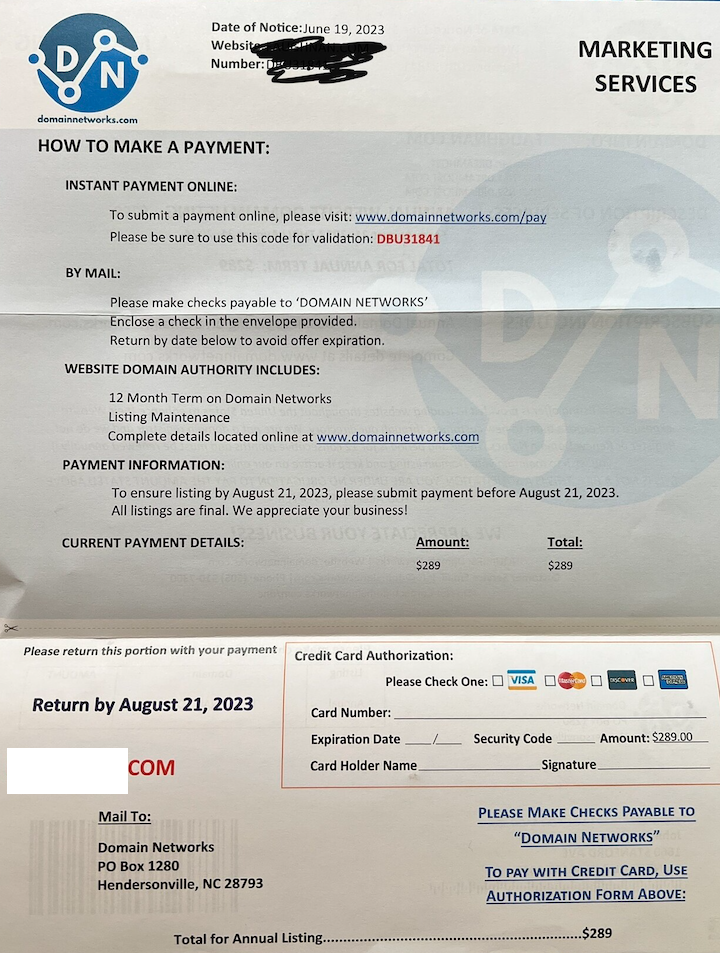
DomainNetworks claims that listing your domain with their promotion services will result in increased traffic to your site. This is a dubious claim for a company that appears to be a complete fabrication, as we’ll see in a moment. But happily, the proprietors of this enterprise were not so difficult to track down.
The website Domainnetworks[.]com says it is a business with a post office box in Hendersonville, N.C., and another address in Santa Fe, N.M. There are a few random, non-technology businesses tied to the phone number listed for the Hendersonville address, and the New Mexico address was used by several no-name web hosting companies.
However, there is little connected to these addresses and phone numbers that get us any closer to finding out who’s running Domainnetworks[.]com. And neither entity appears to be an active, official company in their supposed state of residence, at least according to each state’s Secretary of State database.
The Better Business Bureau listing for DomainNetworks gives it an “F” rating, and includes more than 100 reviews by people angry at receiving one of these scams via snail mail. Helpfully, the BBB says DomainNetworks previously operated under a different name: US Domain Authority LLC.
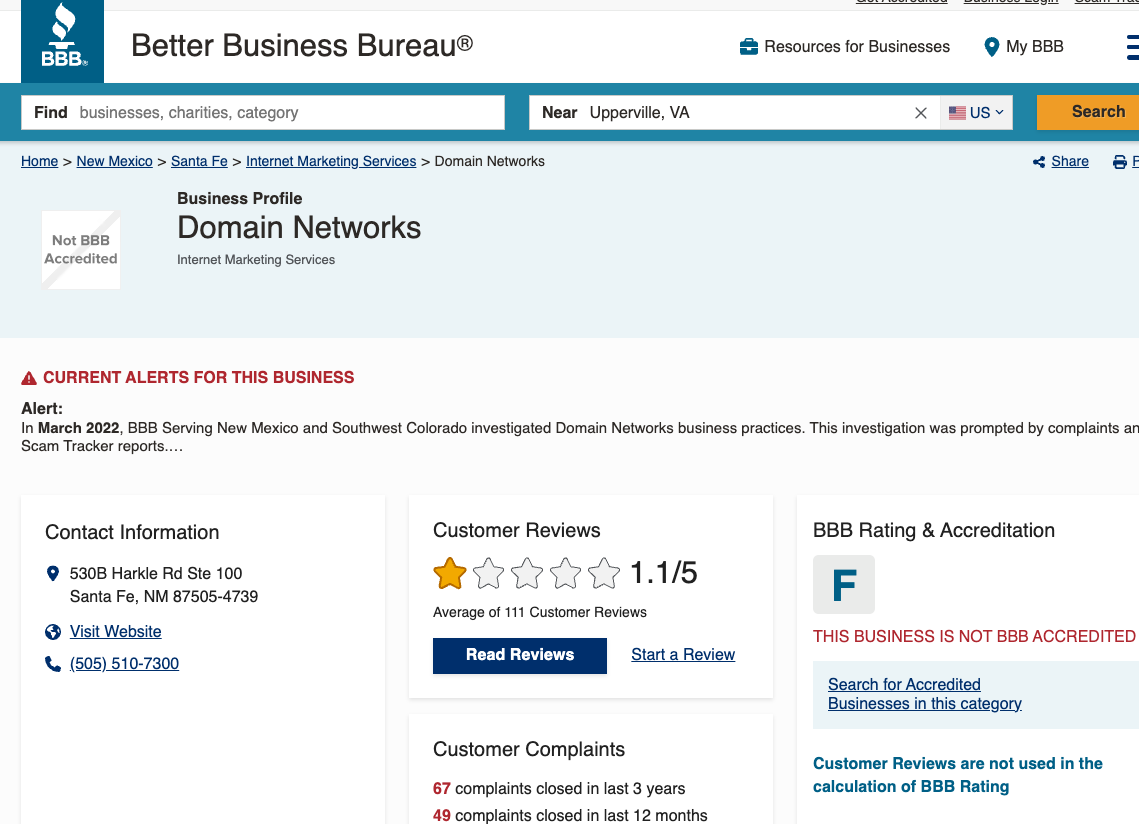
DomainNetworks has an “F” reputation with the Better Business Bureau.
Copies of snail mail scam letters from US Domain Authority posted online show that this entity used the domain usdomainauthority[.]com, registered in May 2022. The Usdomainauthority mailer also featured a Henderson, NC address, albeit at a different post office box.
Usdomainauthority[.]com is no longer online, and the site seems to have blocked its pages from being indexed by the Wayback Machine at archive.org. But searching on a long snippet of text from DomainNetworks[.]com about refund requests shows that this text was found on just one other active website, according to publicwww.com, a service that indexes the HTML code of existing websites and makes it searchable.

A deceptive snail mail solicitation from DomainNetwork’s previous iteration — US Domain Authority. Image: Joerussori.com
That other website is a domain registered in January 2023 called thedomainsvault[.]com, and its registration details are likewise hidden behind privacy services. Thedomainsvault’s “Frequently Asked Questions” page is quite similar to the one on the DomainNetworks website; both begin with the question of why the company is sending a mailer that looks like a bill for domain services.
Thedomainsvault[.]com includes no useful information about the entity or people who operate it; clicking the “Contact-us” link on the site brings up a page with placeholder Lorem Ipsum text, a contact form, and a phone number of 123456789.
However, searching passive DNS records at DomainTools.com for thedomainsvault[.]com shows that at some point whoever owns the domain instructed incoming email to be sent to ubsagency@gmail.com.
The first result that currently pops up when searching for “ubsagency” in Google is ubsagency[.]com, which says it belongs to a Las Vegas-based Search Engine Optimization (SEO) and digital marketing concern generically named both United Business Service and United Business Services. UBSagency’s website is hosted at the same Ann Arbor, Mich. based hosting firm (A2 Hosting Inc) as thedomainsvault[.]com.
UBSagency’s LinkedIn page says the company has offices in Vegas, Half Moon Bay, Calif., and Renton, Wash. But once again, none of the addresses listed for these offices reveal any obvious clues about who runs UBSagency. And once again, none of these entities appear to exist as official businesses in their claimed state of residence.
Searching on ubsagency@gmail.com in Constella Intelligence shows the address was used sometime before February 2019 to create an account under the name “Sammy\Sam_Alon” at the interior decorating site Houzz.com. In January 2019, Houzz acknowledged that a data breach exposed account information on an undisclosed number of customers, including user IDs, one-way encrypted passwords, IP addresses, city and ZIP codes, as well as Facebook information.
Sammy\Sam_Alon registered at Houzz using an Internet address in Huntsville, Ala. (68.35.149.206). Constella says this address was associated with the email tropicglobal@gmail.com, which also is tied to several other “Sammy” accounts at different stores online.
Constella also says a highly unique password re-used by tropicglobal@gmail.com across numerous sites was used in connection with just a few other email accounts, including shenhavgroup@gmail.com, and distributorinvoice@mail.com.
The shenhavgroup@gmail.com address was used to register a Twitter account for a Sam Orit Alon in 2013, whose account says they are affiliated with the Shenhav Group. According to DomainTools, shenhavgroup@gmail.com was responsible for registering roughly two dozen domains, including the now-defunct unitedbusinessservice[.]com.
Constella further finds that the address distributorinvoice@mail.com was used to register an account at whmcs.com, a web hosting platform that suffered a breach of its user database several years back. The name on the WHMCS account was Shmuel Orit Alon, from Kidron, Israel.
UBSagency also has a Facebook page, or maybe “had” is the operative word because someone appears to have defaced it. Loading the Facebook page for UBSagency shows several of the images have been overlaid or replaced with a message from someone who is really disappointed with Sam Alon.
“Sam Alon is a LIAR, THIEF, COWARD AND HAS A VERY SMALL D*CK,” reads one of the messages:

The current Facebook profile page for UBSagency includes a logo that is similar to the DomainNetworks logo.
The logo in the UBSagency profile photo includes a graphic of what appears to be a magnifying glass with a line that zig-zags through bullet points inside and outside the circle, a unique pattern that is remarkably similar to the logo for DomainNetworks:

The logos for DomainNetworks (left) and UBSagency.
Constella also found that the same Huntsville IP address used by Sam Alon at Houzz was associated with yet another Houzz account, this one for someone named “Eliran.”
The UBSagency Facebook page features several messages from an Eliran “Dani” Benz, who is referred to by commenters as an employee or partner with UBSagency. The last check-in on Benz’s profile is from a beach at Rishon Letziyon in Israel earlier this year.
Neither Mr. Alon nor Mr. Benz responded to multiple requests for comment.
It may be difficult to believe that anyone would pay an invoice for a domain name or SEO service they never ordered. However, there is plenty of evidence that these phony bills often get processed by administrative personnel at organizations that end up paying the requested amount because they assume it was owed for some services already provided.
In 2018, KrebsOnSecurity published How Internet Savvy are Your Leaders?, which examined public records to show that dozens of cities, towns, school districts and even political campaigns across the United States got snookered into paying these scam domain invoices from a similar scam company called WebListings Inc.
In 2020, KrebsOnSecurity featured a deep dive into who was likely behind the WebListings scam, which had been sending out these snail mail scam letters for over a decade. That investigation revealed the scam’s connection to a multi-level marketing operation run out of the U.K., and to two brothers living in Scotland.
The U.S. government agency in charge of improving the nation’s cybersecurity posture is ordering all federal agencies to take new measures to restrict access to Internet-exposed networking equipment. The directive comes amid a surge in attacks targeting previously unknown vulnerabilities in widely used security and networking appliances.

Under a new order from the Cybersecurity and Infrastructure Security Agency (CISA), federal agencies will have 14 days to respond to any reports from CISA about misconfigured or Internet-exposed networking equipment. The directive applies to any networking devices — such as firewalls, routers and load balancers — that allow remote authentication or administration.
The order requires federal departments to limit access so that only authorized users on an agency’s local or internal network can reach the management interfaces of these devices. CISA’s mandate follows a slew of recent incidents wherein attackers exploited zero-day flaws in popular networking products to conduct ransomware and cyber espionage attacks on victim organizations.
Earlier today, incident response firm Mandiant revealed that since at least October 2022, Chinese cyber spies have been exploiting a zero-day vulnerability in many email security gateway (ESG) appliances sold by California-based Barracuda Networks to hoover up email from organizations using these devices.
Barracuda was alerted to the exploitation of a zero-day in its products in mid-May, and two days later the company pushed a security update to address the flaw in all affected devices. But last week, Barracuda took the highly unusual step of offering to replace compromised ESGs, evidently in response to malware that altered the systems in such a fundamental way that they could no longer be secured remotely with software updates.
According to Mandiant, a previously unidentified Chinese hacking group was responsible for exploiting the Barracuda flaw, and appeared to be searching through victim organization email records for accounts “belonging to individuals working for a government with political or strategic interest to [China] while this victim government was participating in high-level, diplomatic meetings with other countries.”
When security experts began raising the alarm about a possible zero-day in Barracuda’s products, the Chinese hacking group altered their tactics, techniques and procedures (TTPs) in response to Barracuda’s efforts to contain and remediate the incident, Mandiant found.
Mandiant said the attackers will continue to change their tactics and malware, “especially as network defenders continue to take action against this adversary and their activity is further exposed by the infosec community.”
Meanwhile, this week we learned more details about the ongoing exploitation of a zero-day flaw in a broad range of virtual private networking (VPN) products made by Fortinet — devices many organizations rely on to facilitate remote network access for employees.
On June 11, Fortinet released a half-dozen security updates for its FortiOS firmware, including a weakness that researchers said allows an attacker to run malware on virtually any Fortinet SSL VPN appliance. The researchers found that just being able to reach the management interface for a vulnerable Fortinet SSL VPN appliance was enough to completely compromise the devices.
“This is reachable pre-authentication, on every SSL VPN appliance,” French vulnerability researcher Charles Fol tweeted. “Patch your #Fortigate.”
In details published on June 12, Fortinet confirmed that one of the vulnerabilities (CVE-2023-27997) is being actively exploited. The company said it discovered the weakness in an internal code audit that began in January 2023 — when it learned that Chinese hackers were exploiting a different zero-day flaw in its products.
Shodan.io, the search engine made for finding Internet of Things devices, reports that there are currently more than a half-million vulnerable Fortinet devices reachable via the public Internet.
The new cybersecurity directive from CISA orders agencies to remove any networking device management interfaces from the internet by making them only accessible from an internal enterprise network (CISA recommends an isolated management network). CISA also says agencies should “deploy capabilities, as part of a Zero Trust Architecture, that enforce access control to the interface through a policy enforcement point separate from the interface itself (preferred action).”
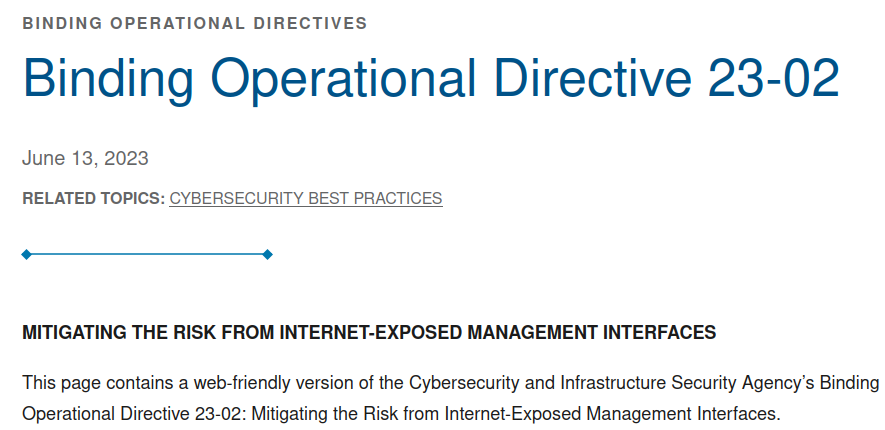
Security experts say CISA’s directive highlights the reality that cyberspies and ransomware gangs are making it increasingly risky for organizations to expose any devices to the public Internet, because these groups have strong incentives to probe such devices for previously unknown security vulnerabilities.
The most glaring example of this dynamic can be seen in the frequency with which ransomware groups have discovered and pounced on zero-day flaws in widely-used file transfer applications. One ransomware gang in particular — Cl0p — has repeatedly exploited zero day bugs in various file transfer appliances to extort tens of millions of dollars from hundreds of ransomware victims.
On February 2, KrebsOnSecurity broke the news that attackers were exploiting a zero-day vulnerability in the GoAnywhere file transfer appliance by Fortra. By the time security updates were available to fix the vulnerability, Cl0p had already used it to steal data from more than a hundred organizations running Fortra’s appliance.
According to CISA, on May 27, Cl0p began exploiting a previously unknown flaw in MOVEit Transfer, a popular Internet-facing file transfer application. MOVEit parent Progress Software has since released security updates to address the weakness, but Cl0p claims to have already used it to compromise hundreds of victim organizations. TechCrunch has been tracking the fallout from victim organizations, which range from banks and insurance providers to universities and healthcare entities.
The always on-point weekly security news podcast Risky Business has recently been urging organizations to jettison any and all FTP appliances, noting that Cl0p (or another crime gang) is likely to visit the same treatment on other FTP appliance vendors.
But that sound advice doesn’t exactly scale for mid-tier networking devices like Barracuda ESGs or Fortinet SSL VPNs, which are particularly prominent in small to mid-sized organizations.
“It’s not like FTP services, you can’t tell an enterprise [to] turn off the VPN [because] the productivity hit of disconnecting the VPN is terminal, it’s a non-starter,” Risky Business co-host Adam Boileau said on this week’s show. “So how to mitigate the impact of having to use a domain-joined network appliance at the edge of your network that is going to get zero-day in it? There’s no good answer.”
Risky Business founder Patrick Gray said the COVID-19 pandemic breathed new life into entire classes of networking appliances that rely on code which was never designed with today’s threat models in mind.
“In the years leading up to the pandemic, the push towards identity-aware proxies and zero trust everything and moving away from this type of equipment was gradual, but it was happening,” Gray said. “And then COVID-19 hit and everybody had to go work from home, and there really was one option to get going quickly — which was to deploy VPN concentrators with enterprise features.”
Gray said the security industry had been focused on building the next generation of remote access tools that are more security-hardened, but when the pandemic hit organizations scrambled to cobble together whatever they could.
“The only stuff available in the market was all this old crap that is not QA’d properly, and every time you shake them CVEs fall out,” Gray remarked, calling the pandemic, “a shot in the arm” to companies like Fortinet and Barracuda.
“They sold so many VPNs through the pandemic and this is the hangover,” Gray said. “COVID-19 extended the life of these companies and technologies, and that’s unfortunate.”
Microsoft today released software updates to fix at least four dozen security holes in its Windows operating systems and other software, including patches for two zero-day vulnerabilities that are already being exploited in active attacks.
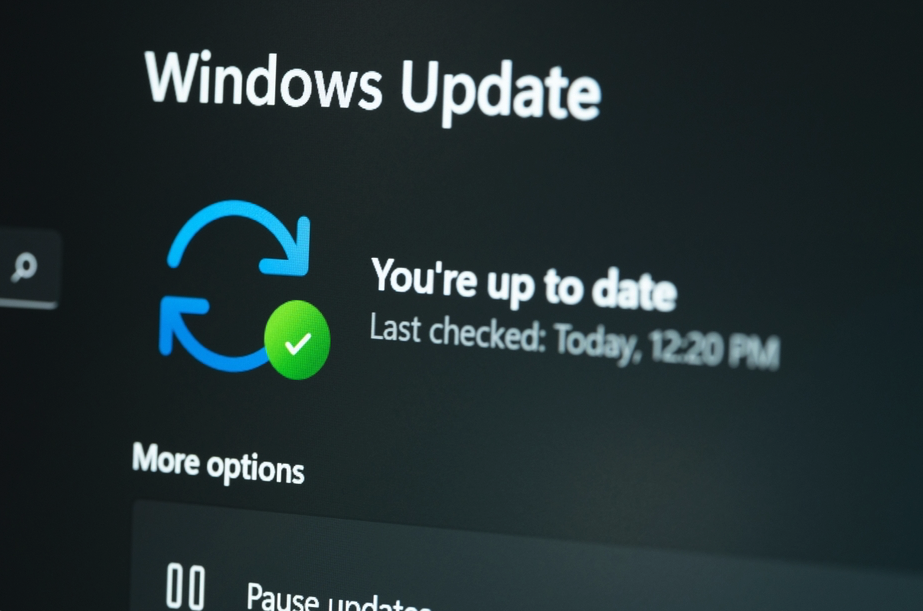
First up in May’s zero-day flaws is CVE-2023-29336, which is an “elevation of privilege” weakness in Windows which has a low attack complexity, requires low privileges, and no user interaction. However, as the SANS Internet Storm Center points out, the attack vector for this bug is local.
“Local Privilege escalation vulnerabilities are a key part of attackers’ objectives,” said Kevin Breen, director of cyber threat research at Immersive Labs. “Once they gain initial access they will seek administrative or SYSTEM-level permissions. This can allow the attacker to disable security tooling and deploy more attacker tools like Mimikatz that lets them move across the network and gain persistence.”
The zero-day patch that has received the most attention so far is CVE-2023-24932, which is a Secure Boot Security Feature Bypass flaw that is being actively exploited by “bootkit” malware known as “BlackLotus.” A bootkit is dangerous because it allows the attacker to load malicious software before the operating system even starts up.
According to Microsoft’s advisory, an attacker would need physical access or administrative rights to a target device, and could then install an affected boot policy. Microsoft gives this flaw a CVSS score of just 6.7, rating it as “Important.”
Adam Barnett, lead software engineer at Rapid7, said CVE-2023-24932 deserves a considerably higher threat score.
“Microsoft warns that an attacker who already has Administrator access to an unpatched asset could exploit CVE-2023-24932 without necessarily having physical access,” Barnett said. “Therefore, the relatively low CVSSv3 base score of 6.7 isn’t necessarily a reliable metric in this case.”
Barnett said Microsoft has provided a supplementary guidance article specifically calling out the threat posed by BlackLotus malware, which loads ahead of the operating system on compromised assets, and provides attackers with an array of powerful evasion, persistence, and Command & Control (C2) techniques, including deploying malicious kernel drivers, and disabling Microsoft Defender or Bitlocker.
“Administrators should be aware that additional actions are required beyond simply applying the patches,” Barnett advised. “The patch enables the configuration options necessary for protection, but administrators must apply changes to UEFI config after patching. The attack surface is not limited to physical assets, either; Windows assets running on some VMs, including Azure assets with Secure Boot enabled, also require these extra remediation steps for protection. Rapid7 has noted in the past that enabling Secure Boot is a foundational protection against driver-based attacks. Defenders ignore this vulnerability at their peril.”
In addition to the two zero-days fixed this month, Microsoft also patched five remote code execution (RCE) flaws in Windows, two of which have notably high CVSS scores.
CVE-2023-24941 affects the Windows Network File System, and can be exploited over the network by making an unauthenticated, specially crafted request. Microsoft’s advisory also includes mitigation advice. The CVSS for this vulnerability is 9.8 – the highest of all the flaws addressed this month.
Meanwhile, CVE-2023-28283 is a critical bug in the Windows Lightweight Directory Access Protocol (LDAP) that allows an unauthenticated attacker to execute malicious code on the vulnerable device. The CVSS for this vulnerability is 8.1, but Microsoft says exploiting the flaw may be tricky and unreliable for attackers.
Another vulnerability patched this month that was disclosed publicly before today (but not yet seen exploited in the wild) is CVE-2023-29325, a weakness in Microsoft Outlook and Explorer that can be exploited by attackers to remotely install malware. Microsoft says this vulnerability can be exploited merely by viewing a specially-crafted email in the Outlook Preview Pane.
“To help protect against this vulnerability, we recommend users read email messages in plain text format,” Microsoft’s writeup on CVE-2023-29325 advises.
“If an attacker were able to exploit this vulnerability, they would gain remote access to the victim’s account, where they could deploy additional malware,” Immersive’s Breen said. “This kind of exploit will be highly sought after by e-crime and ransomware groups where, if successfully weaponized, could be used to target hundreds of organizations with very little effort.”
For more details on the updates released today, check out roundups by Action1, Automox and Qualys, If today’s updates cause any stability or usability issues in Windows, AskWoody.com will likely have the lowdown on that.
Please consider backing up your data and/or imaging your system before applying any updates. And feel free to sound off in the comments if you experience any problems as a result of these patches.
A shocking number of organizations — including banks and healthcare providers — are leaking private and sensitive information from their public Salesforce Community websites, KrebsOnSecurity has learned. The data exposures all stem from a misconfiguration in Salesforce Community that allows an unauthenticated user to access records that should only be available after logging in.

A researcher found DC Health had five Salesforce Community sites exposing data.
Salesforce Community is a widely-used cloud-based software product that makes it easy for organizations to quickly create websites. Customers can access a Salesforce Community website in two ways: Authenticated access (requiring login), and guest user access (no login required). The guest access feature allows unauthenticated users to view specific content and resources without needing to log in.
However, sometimes Salesforce administrators mistakenly grant guest users access to internal resources, which can cause unauthorized users to access an organization’s private information and lead to potential data leaks.
Until being contacted by this reporter on Monday, the state of Vermont had at least five separate Salesforce Community sites that allowed guest access to sensitive data, including a Pandemic Unemployment Assistance program that exposed the applicant’s full name, Social Security number, address, phone number, email, and bank account number.

This misconfigured Salesforce Community site from the state of Vermont was leaking pandemic assistance loan application data, including names, SSNs, email address and bank account information.
Vermont’s Chief Information Security Officer Scott Carbee said his security teams have been conducting a full review of their Salesforce Community sites, and already found one additional Salesforce site operated by the state that was also misconfigured to allow guest access to sensitive information.
“My team is frustrated by the permissive nature of the platform,” Carbee said.
Carbee said the vulnerable sites were all created rapidly in response to the Coronavirus pandemic, and were not subjected to their normal security review process.
“During the pandemic, we were largely standing up tons of applications, and let’s just say a lot of them didn’t have the full benefit of our dev/ops process,” Carbee said. “In our case, we didn’t have any native Salesforce developers when we had to suddenly stand up all these sites.”
Earlier this week, KrebsOnSecurity notified Columbus, Ohio-based Huntington Bank that its recently acquired TCF Bank had a Salesforce Community website that was leaking documents related to commercial loans. The data fields in those loan applications included name, address, full Social Security number, title, federal ID, IP address, average monthly payroll, and loan amount.
Huntington Bank has disabled the leaky TCF Bank Salesforce website. Matthew Jennings, deputy chief information security officer at Huntington, said the company was still investigating how the misconfiguration occurred, how long it lasted, and how many records may have been exposed.
KrebsOnSecurity learned of the leaks from security researcher Charan Akiri, who said he wrote a program that identified hundreds of other organizations running misconfigured Salesforce pages. But Akiri said he’s been wary of probing too far, and has had difficulty getting responses from most of the organizations he has notified to date.
“In January and February 2023, I contacted government organizations and several companies, but I did not receive any response from these organizations,” Akiri said. “To address the issue further, I reached out to several CISOs on LinkedIn and Twitter. As a result, five companies eventually fixed the problem. Unfortunately, I did not receive any responses from government organizations.”
The problem Akiri has been trying to raise awareness about came to the fore in August 2021, when security researcher Aaron Costello published a blog post explaining how misconfigurations in Salesforce Community sites could be exploited to reveal sensitive data (Costello subsequently published a follow-up post detailing how to lock down Salesforce Community sites).
On Monday, KrebsOnSecurity used Akiri’s findings to notify Washington D.C. city administrators that at least five different public DC Health websites were leaking sensitive information. One DC Health Salesforce Community website designed for health professionals seeking to renew licenses with the city leaked documents that included the applicant’s full name, address, Social Security number, date of birth, license number and expiration, and more.
Akiri said he notified the Washington D.C. government in February about his findings, but received no response. Reached by KrebsOnSecurity, interim Chief Information Security Officer Mike Rupert initially said the District had hired a third party to investigate, and that the third party confirmed the District’s IT systems were not vulnerable to data loss from the reported Salesforce configuration issue.
But after being presented with a document including the Social Security number of a health professional in D.C. that was downloaded in real-time from the DC Health public Salesforce website, Rupert acknowledged his team had overlooked some configuration settings.
Washington, D.C. health administrators are still smarting from a data breach earlier this year at the health insurance exchange DC Health Link, which exposed personal information for more than 56,000 users, including many members of Congress.
That data later wound up for sale on a top cybercrime forum. The Associated Press reports that the DC Health Link breach was likewise the result of human error, and said an investigation revealed the cause was a DC Health Link server that was “misconfigured to allow access to the reports on the server without proper authentication.”
Salesforce says the data exposures are not the result of a vulnerability inherent to the Salesforce platform, but they can occur when customers’ access control permissions are misconfigured.
“As previously communicated to all Experience Site and Sites customers, we recommend utilizing the Guest User Access Report Package to assist in reviewing access control permissions for unauthenticated users,” reads a Salesforce advisory from Sept. 2022. “Additionally, we suggest reviewing the following Help article, Best Practices and Considerations When Configuring the Guest User Profile.”
In a written statement, Salesforce said it is actively focused on data security for organizations with guest users, and that it continues to release “robust tools and guidance for our customers,” including:
Control Which Users Experience Cloud Site Users Can See
Best Practices and Considerations When Configuring the Guest User Profile
“We’ve also continued to update our Guest User security policies, beginning with our Spring ‘21 release with more to come in Summer ‘23,” the statement reads. “Lastly, we continue to proactively communicate with customers to help them understand the capabilities available to them, and how they can best secure their instance of Salesforce to meet their security, contractual, and regulatory obligations.”





We learned some remarkable new details this week about the recent supply-chain attack on VoIP software provider 3CX. The lengthy, complex intrusion has all the makings of a cyberpunk spy novel: North Korean hackers using legions of fake executive accounts on LinkedIn to lure people into opening malware disguised as a job offer; malware targeting Mac and Linux users working at defense and cryptocurrency firms; and software supply-chain attacks nested within earlier supply chain attacks.
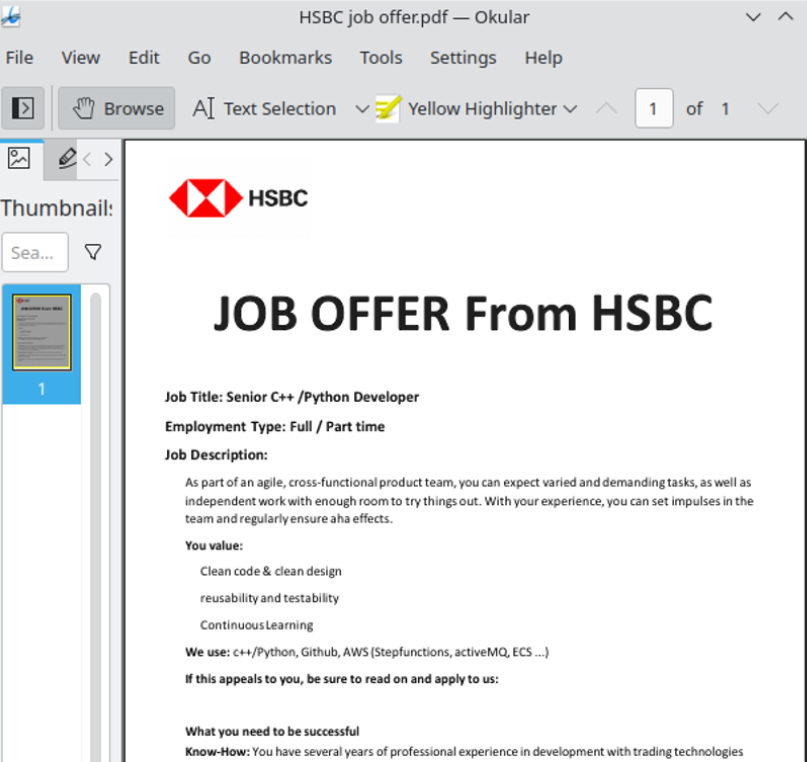
Researchers at ESET say this job offer from a phony HSBC recruiter on LinkedIn was North Korean malware masquerading as a PDF file.
In late March 2023, 3CX disclosed that its desktop applications for both Windows and macOS were compromised with malicious code that gave attackers the ability to download and run code on all machines where the app was installed. 3CX says it has more than 600,000 customers and 12 million users in a broad range of industries, including aerospace, healthcare and hospitality.
3CX hired incident response firm Mandiant, which released a report on Wednesday that said the compromise began in 2022 when a 3CX employee installed a malware-laced software package distributed via an earlier software supply chain compromise that began with a tampered installer for X_TRADER, a software package provided by Trading Technologies.
“This is the first time Mandiant has seen a software supply chain attack lead to another software supply chain attack,” reads the April 20 Mandiant report.
Mandiant found the earliest evidence of compromise uncovered within 3CX’s network was through the VPN using the employee’s corporate credentials, two days after the employee’s personal computer was compromised.
“Eventually, the threat actor was able to compromise both the Windows and macOS build environments,” 3CX said in an April 20 update on their blog.
Mandiant concluded that the 3CX attack was orchestrated by the North Korean state-sponsored hacking group known as Lazarus, a determination that was independently reached earlier by researchers at Kaspersky Lab and Elastic Security.
Mandiant found the compromised 3CX software would download malware that sought out new instructions by consulting encrypted icon files hosted on GitHub. The decrypted icon files revealed the location of the malware’s control server, which was then queried for a third stage of the malware compromise — a password stealing program dubbed ICONICSTEALER.
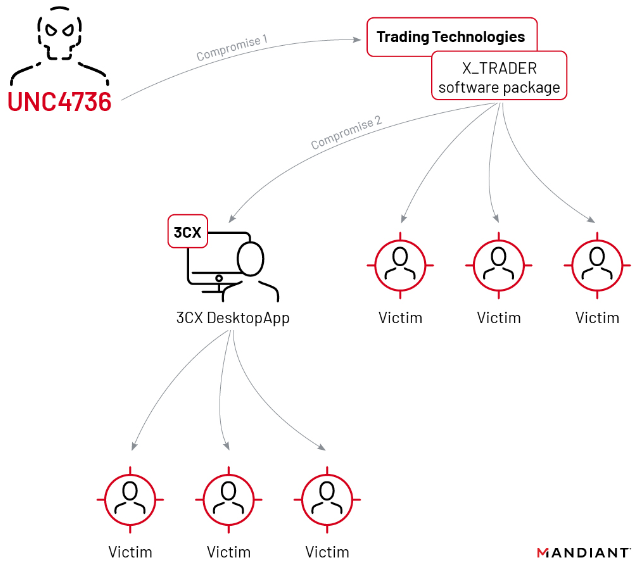
The double supply chain compromise that led to malware being pushed out to some 3CX customers. Image: Mandiant.
Meanwhile, the security firm ESET today published research showing remarkable similarities between the malware used in the 3CX supply chain attack and Linux-based malware that was recently deployed via fake job offers from phony executive profiles on LinkedIn. The researchers said this was the first time Lazarus had been spotted deploying malware aimed at Linux users.
As reported in a series last summer here, LinkedIn has been inundated this past year by fake executive profiles for people supposedly employed at a range of technology, defense, energy and financial companies. In many cases, the phony profiles spoofed chief information security officers at major corporations, and some attracted quite a few connections before their accounts were terminated.
Mandiant, Proofpoint and other experts say Lazarus has long used these bogus LinkedIn profiles to lure targets into opening a malware-laced document that is often disguised as a job offer. This ongoing North Korean espionage campaign using LinkedIn was first documented in August 2020 by ClearSky Security, which said the Lazarus group operates dozens of researchers and intelligence personnel to maintain the campaign globally.
Microsoft Corp., which owns LinkedIn, said in September 2022 that it had detected a wide range of social engineering campaigns using a proliferation of phony LinkedIn accounts. Microsoft said the accounts were used to impersonate recruiters at technology, defense and media companies, and to entice people into opening a malicious file. Microsoft found the attackers often disguised their malware as legitimate open-source software like Sumatra PDF and the SSH client Putty.
Microsoft attributed those attacks to North Korea’s Lazarus hacking group, although they’ve traditionally referred to this group as “ZINC“. That is, until earlier this month, when Redmond completely revamped the way it names threat groups; Microsoft now references ZINC as “Diamond Sleet.”
The ESET researchers said they found a new fake job lure tied to an ongoing Lazarus campaign on LinkedIn designed to compromise Linux operating systems. The malware was found inside of a document that offered an employment contract at the multinational bank HSBC.
“A few weeks ago, a native Linux payload was found on VirusTotal with an HSBC-themed PDF lure,” wrote ESET researchers Peter Kalnai and Marc-Etienne M.Leveille. “This completes Lazarus’s ability to target all major desktop operating systems. In this case, we were able to reconstruct the full chain, from the ZIP file that delivers a fake HSBC job offer as a decoy, up until the final payload.”
ESET said the malicious PDF file used in the scheme appeared to have a file extension of “.pdf,” but that this was a ruse. ESET discovered that the dot in the filename wasn’t a normal period but instead a Unicode character (U+2024) representing a “leader dot,” which is often used in tables of contents to connect section headings with the page numbers on which those sections begin.
“The use of the leader dot in the filename was probably an attempt to trick the file manager into treating the file as an executable instead of a PDF,” the researchers continued. “This could cause the file to run when double-clicked instead of opening it with a PDF viewer.”
ESET said anyone who opened the file would see a decoy PDF with a job offer from HSBC, but in the background the executable file would download additional malware payloads. The ESET team also found the malware was able to manipulate the program icon displayed by the malicious PDF, possibly because fiddling with the file extension could cause the user’s system to display a blank icon for the malware lure.
Kim Zetter, a veteran Wired.com reporter and now independent security journalist, interviewed Mandiant researchers who said they expect “many more victims” will be discovered among the customers of Trading Technologies and 3CX now that news of the compromised software programs is public.
“Mandiant informed Trading Technologies on April 11 that its X_Trader software had been compromised, but the software maker says it has not had time to investigate and verify Mandiant’s assertions,” Zetter wrote in her Zero Day newsletter on Substack. For now, it remains unclear whether the compromised X_Trader software was downloaded by people at other software firms.
If there’s a silver lining here, the X_Trader software had been decommissioned in April 2020 — two years before the hackers allegedly embedded malware in it.
“The company hadn’t released new versions of the software since that time and had stopped providing support for the product, making it a less-than-ideal vector for the North Korean hackers to infect customers,” Zetter wrote.
For the past seven years, a malware-based proxy service known as “Faceless” has sold anonymity to countless cybercriminals. For less than a dollar per day, Faceless customers can route their malicious traffic through tens of thousands of compromised systems advertised on the service. In this post we’ll examine clues left behind over the past decade by the proprietor of Faceless, including some that may help put a face to the name.
Riley Kilmer is co-founder of Spur.us, a company that tracks thousands of VPN and proxy networks, and helps customers identify traffic coming through these anonymity services. Kilmer said Faceless has emerged as one of the underground’s most reliable malware-based proxy services, mainly because its proxy network has traditionally included a great many compromised “Internet of Things” devices — such as media sharing servers — that are seldom included on malware or spam block lists.
Kilmer said when Spur first started looking into Faceless, they noticed almost every Internet address that Faceless advertised for rent also showed up in the IoT search engine Shodan.io as a media sharing device on a local network that was somehow exposed to the Internet.
“We could reliably look up the [fingerprint] for these media sharing devices in Shodan and find those same systems for sale on Faceless,” Kilmer said.
In January 2023, the Faceless service website said it was willing to pay for information about previously undocumented security vulnerabilities in IoT devices. Those with IoT zero-days could expect payment if their exploit involved at least 5,000 systems that could be identified through Shodan.
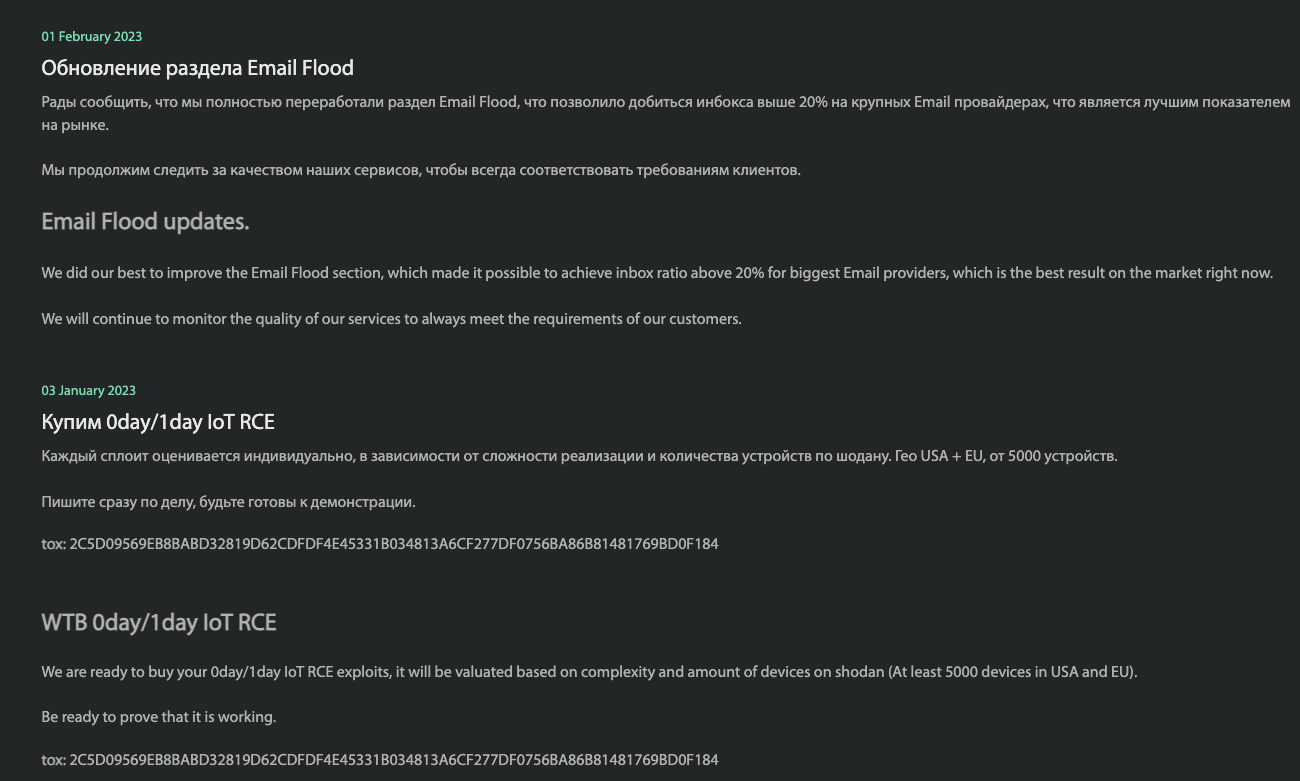
Notices posted for Faceless users, advertising an email flooding service and soliciting zero-day vulnerabilities in Internet of Things devices.
Recently, Faceless has shown ambitions beyond just selling access to poorly-secured IoT devices. In February, Faceless re-launched a service that lets users drop an email bomb on someone — causing the target’s inbox to be filled with tens of thousands of junk messages.
And in March 2023, Faceless started marketing a service for looking up Social Security Numbers (SSNs) that claims to provide access to “the largest SSN database on the market with a very high hit rate.”
Kilmer said Faceless wants to become a one-stop-fraud-shop for cybercriminals who are seeking stolen or synthetic identities from which to transact online, and a temporary proxy that is geographically close to the identity being sold. Faceless currently sells this bundled product for $9 — $8 for the identity and $1 for the proxy.
“They’re trying to be this one-stop shop for anonymity and personas,” Kilmer said. “The service basically says ‘here’s an SSN and proxy connection that should correspond to that user’s location and make sense to different websites.'”
Faceless is a project from MrMurza, a particularly talkative member of more than a dozen Russian-language cybercrime forums over the past decade. According to cyber intelligence firm Flashpoint, MrMurza has been active in the Russian underground since at least September 2012. Flashpoint said MrMurza appears to be extensively involved in botnet activity and “drops” — fraudulent bank accounts created using stolen identity data that are often used in money laundering and cash-out schemes.
Faceless grew out of a popular anonymity service called iSocks, which was launched in 2014 and advertised on multiple Russian crime forums as a proxy service that customers could use to route their malicious Web traffic through compromised computers.
Flashpoint says that in the months before iSocks went online, MrMurza posted on the Russian language crime forum Verified asking for a serious partner to assist in opening a proxy service, noting they had a botnet that was powered by malware that collected proxies with a 70 percent infection rate.

MrMurza’s Faceless advertised on the Russian-language cybercrime forum ProCrd. Image: Darkbeast/Ke-la.com.
In September 2016, MrMurza sent a message to all iSocks users saying the service would soon be phased out in favor of Faceless, and that existing iSocks users could register at Faceless for free if they did so quickly — before Faceless began charging new users registration fees between $50 and $100.
Verified and other Russian language crime forums where MrMurza had a presence have been hacked over the years, with contact details and private messages leaked online. In a 2014 private message to the administrator of Verified explaining his bona fides, MrMurza said he received years of positive feedback as a seller of stolen Italian credit cards and a vendor of drops services.
MrMurza told the Verified admin that he used the nickname AccessApproved on multiple other forums over the years. MrMurza also told the admin that his account number at the now-defunct virtual currency Liberty Reserve was U1018928.
According to cyber intelligence firm Intel 471, the user AccessApproved joined the Russian crime forum Zloy in Jan. 2012, from an Internet address in Magnitogorsk, RU. In a 2012 private message where AccessApproved was arguing with another cybercriminal over a deal gone bad, AccessApproved asked to be paid at the Liberty Reserve address U1018928.
In 2013, U.S. federal investigators seized Liberty Reserve and charged its founders with facilitating billions of dollars in money laundering tied to cybercrime. The Liberty Reserve case was prosecuted out of the Southern District of New York, which in 2016 published a list of account information (PDF) tied to thousands of Liberty Reserve addresses the government asserts were involved in money laundering.
That document indicates the Liberty Reserve account claimed by MrMurza/AccessApproved — U1018928 — was assigned in 2011 to a “Vadim Panov” who used the email address lesstroy@mgn.ru.
Constella Intelligence, a threat intelligence firm that tracks breached databases, says lesstroy@mgn.ru was used for an account “Hackerok” at the accounting service klerk.ru that was created from an Internet address in Magnitogorsk. The password chosen by this user was “1232.”
In addition to selling access to hacked computers and bank accounts, both MrMurza and AccessApproved ran side hustles on the crime forums selling clothing from popular retailers that refused to ship directly to Russia.
On one cybercrime forum where AccessApproved had clothing customers, denizens of the forum created a lengthy discussion thread to help users identify incoming emails associated with various reshipping services advertised within their community. Reshippers tend to rely on a large number of people in the United States and Europe helping to forward packages overseas, but in many cases the notifications about purchases and shipping details would be forwarded to reshipping service customers from a consistent email account.
That thread said AccessApproved’s clothing reshipping service forwarded confirmation emails from the address panov-v@mail.ru. This address is associated with accounts on two Russian cybercrime forums registered from Magnitogorsk in 2010 using the handle “Omega^gg4u.”
This Omega^gg4u identity sold software that can rapidly check the validity of large batches of stolen credit cards. Interestingly, both Omega^gg4u and AccessApproved also had another niche: Reselling heavily controlled substances — such as human growth hormone and anabolic steroids — from chemical suppliers in China.
A search in Constella on the address panov-v@mail.ru and many variations on that address shows these accounts cycled through the same passwords, including 055752403k, asus666, 01091987h, and the relatively weak password 1232 (recall that 1232 was picked by whoever registered the lesstroy@mgn.ru account at Klerk.ru).
Constella says the email address asus666@yandex.ru relied on the passwords asus666 and 01091987h. The 01091987h password also was used by asus666@mail.ru, which also favored the password 24587256.
Constella further reports that whoever owned the much shorter address asus@mail.ru also used the password 24587256. In addition, it found the password 2318922479 was tied to both asus666@mail.ru and asus@mail.ru.
The email addresses asus@mail.ru, asus2504@mail.ru, and zaxar2504@rambler.ru were all used to register Vkontakte social media accounts for a Denis ***@VIP*** Pankov. There are a number of other Vkontakte accounts registered to asus@mail.ru and many variations of this address under a different name. But none of those other profiles appear tied to real-life identities.
Constella’s data shows the email addresses asus2504@mail.ru and zaxar2504@rambler.ru used the rather unique password denis250485, which was also used by the email address denispankov@yandex.ru and almost a dozen variations at other Russian-language email providers.
Russian vehicle registration records from 2016 show the email address denispankov@yandex.ru belongs to Denis Viktorovich Pankov, born on April 25, 1985. That explains the “250485” portion of Pankov’s favored password. The registration records further indicate that in 2016 Pankov’s vehicle was registered in a suburb of Moscow.
Russian incorporation records show that denispankov@yandex.com is tied to IP Pankov Denis Viktorovich, a now-defunct transportation company in the Volograd Oblast, a region in southern Russia that shares a long border with western Kazazkhstan.
More recent records for IP Pankov Denis Viktorovich show a microenterprise with this name in Omsk that described its main activity as “retail sale by mail or via the Internet.” Russian corporate records indicate this entity was liquidated in 2021.
A reverse password search on “denis250485” via Constella shows this password was used by more than 75 email addresses, most of which are some variation of gaihnik@mail.ru — such as gaihnik25@mail.ru, or gaihnik2504@rambler.ru.
In 2012, someone posted answers to a questionnaire on behalf of Denis Viktorovich Pankov to a Russian-language discussion forum on Chinese crested dog breeds. The message said Pankov was seeking a puppy of a specific breed and was a resident of Krasnogorsk, a city that is adjacent to the northwestern boundary of Moscow.
The message said Pankov was a then 27-year-old manager in an advertising company, and could be reached at the email address gaihnik@mail.ru.
Constella Intelligence shows gaihnik@mail.ru registered at the now-defunct email marketing service Smart Responder from an address in Gagarin, which is about 115 miles west of Moscow.
Back in 2015, the user Gaihnik25 was banned from the online game World of Tanks for violating the game’s terms that prohibit “bot farming,” or the automated use of large numbers of player accounts to win some advantage that is usually related to cashing out game accounts or inventory.
For the past few years, someone using the nickname Gaihnik25 has been posting messages to the Russian-language hacking forum Gerki[.]pw, on discussion threads regarding software designed to “brute force” or mass-check online accounts for weak or compromised passwords.
A new member of the Russian hacking forum Nohide[.]Space using the handle Gaihnik has been commenting recently about proxy services, credential checking software, and the sale of hacked mailing lists. Gaihnik’s first post on the forum concerned private software for checking World of Tanks accounts.
The address gaihnik@mail.ru shows how so many email addresses tied to Pankov were also connected to apparently misleading identities on Vkontakte and elsewhere. Constella found this address was tied to a Vkontakte account for a Dmitriy Zakarov.
Microsoft’s Bing search engine says gaihnik@mail.ru belongs to 37-year-old Denis Pankov, yet clicking the Mail.ru profile for that user brings up a profile for a much older man by the name Gavril Zakarov. However, when you log in to a Mail.ru account and view that profile, it shows that most of the account’s profile photos are of a much younger man.
Many of those same photos show up in an online dating profile at dating.ru for the user Gaihnik, a.k.a “Denchik,” who says he is a 37-year-old Taurus from Gagarin who enjoys going for walks in nature, staying up late, and being on the Internet.
Mr. Pankov did not respond to multiple requests for comment sent to all of the email addresses mentioned in this story. However, some of those addresses produced detailed error responses; Mail.ru reported that the users panov-v@mail.ru, asus666@mail.ru, and asus2504@mail.ru were terminated, and that gaihnik25@mail.ru is now disabled.
Messages sent to many other email addresses connected via passwords to Pankov and using some variation of asus####@mail.ru also returned similar account termination messages.



Microsoft today released software updates to plug 100 security holes in its Windows operating systems and other software, including a zero-day vulnerability that is already being used in active attacks. Not to be outdone, Apple has released a set of important updates addressing two zero-day vulnerabilities that are being used to attack iPhones, iPads and Macs.

On April 7, Apple issued emergency security updates to fix two weaknesses that are being actively exploited, including CVE-2023-28206, which can be exploited by apps to seize control over a device. CVE-2023-28205 can be used by a malicious or hacked website to install code.
Both vulnerabilities are addressed in iOS/iPadOS 16.4.1, iOS 15.7.5, and macOS 12.6.5 and 11.7.6. If you use Apple devices and you don’t have automatic updates enabled (they are on by default), you should probably take care of that soon as detailed instructions on how to attack CVE-2023-28206 are now public.
Microsoft’s bevy of 100 security updates released today include CVE-2023-28252, which is a weakness in Windows that Redmond says is under active attack. The vulnerability is in the Windows Common Log System File System (CLFS) driver, a core Windows component that was the source of attacks targeting a different zero-day vulnerability in February 2023.
“If it seems familiar, that’s because there was a similar 0-day patched in the same component just two months ago,” said Dustin Childs at the Trend Micro Zero Day Initiative. “To me, that implies the original fix was insufficient and attackers have found a method to bypass that fix. As in February, there is no information about how widespread these attacks may be. This type of exploit is typically paired with a code execution bug to spread malware or ransomware.”
According to the security firm Qualys, this vulnerability has been leveraged by cyber criminals to deploy Nokoyawa ransomware.
“This is a relatively new strain for which there is some open source intel to suggest that it is possibly related to Hive ransomware – one of the most notable ransomware families of 2021 and linked to breaches of over 300+ organizations in a matter of just a few months,” said Bharat Jogi, director of vulnerability and threat research at Qualys.
Jogi said while it is still unclear which exact threat actor is targeting CVE-2023-28252, targets have been observed in South and North America, regions across Asia and at organizations in the Middle East.
Satnam Narang at Tenable notes that CVE-2023-28252 is also the second CLFS zero-day disclosed to Microsoft by researchers from Mandiant and DBAPPSecurity (CVE-2022-37969), though it is unclear if both of these discoveries are related to the same attacker.
Seven of the 100 vulnerabilities Microsoft fixed today are rated “Critical,” meaning they can be used to install malicious code with no help from the user. Ninety of the flaws earned Redmond’s slightly less-dire “Important” label, which refers to weaknesses that can be used to undermine the security of the system but which may require some amount of user interaction.
Narang said Microsoft has rated nearly 90% of this month’s vulnerabilities as “Exploitation Less Likely,” while just 9.3% of flaws were rated as “Exploitation More Likely.” Kevin Breen at Immersive Labs zeroed in on several notable flaws in that 9.3%, including CVE-2023-28231, a remote code execution vulnerability in a core Windows network process (DHCP) with a CVSS score of 8.8.
“‘Exploitation more likely’ means it’s not being actively exploited but adversaries may look to try and weaponize this one,” Breen said. “Micorosft does note that successful exploitation requires an attacker to have already gained initial access to the network. This could be via social engineering, spear phishing attacks, or exploitation of other services.”
Breen also called attention to CVE-2023-28220 and CVE-2023-28219 — a pair of remote code execution vulnerabilities affecting Windows Remote Access Servers (RAS) that also earned Microsoft’s “exploitation more likely” label.
“An attacker can exploit this vulnerability by sending a specially crafted connection request to a RAS server, which could lead to remote code execution,” Breen said. While not standard in all organizations, RAS servers typically have direct access from the Internet where most users and services are connected. This makes it extremely enticing for attackers as they don’t need to socially engineer their way into an organization. They can simply scan the internet for RAS servers and automate the exploitation of vulnerable devices.”
For more details on the updates released today, see the SANS Internet Storm Center roundup. If today’s updates cause any stability or usability issues in Windows, AskWoody.com will likely have the lowdown on that.
Please consider backing up your data and/or imaging your system before applying any updates. And feel free to sound off in the comments if you experience any problems as a result of these patches.




Microsoft on Tuesday released updates to quash at least 74 security bugs in its Windows operating systems and software. Two of those flaws are already being actively attacked, including an especially severe weakness in Microsoft Outlook that can be exploited without any user interaction.

The Outlook vulnerability (CVE-2023-23397) affects all versions of Microsoft Outlook from 2013 to the newest. Microsoft said it has seen evidence that attackers are exploiting this flaw, which can be done without any user interaction by sending a booby-trapped email that triggers automatically when retrieved by the email server — before the email is even viewed in the Preview Pane.
While CVE-2023-23397 is labeled as an “Elevation of Privilege” vulnerability, that label doesn’t accurately reflect its severity, said Kevin Breen, director of cyber threat research at Immersive Labs.
Known as an NTLM relay attack, it allows an attacker to get someone’s NTLM hash [Windows account password] and use it in an attack commonly referred to as “Pass The Hash.”
“The vulnerability effectively lets the attacker authenticate as a trusted individual without having to know the person’s password,” Breen said. “This is on par with an attacker having a valid password with access to an organization’s systems.”
Security firm Rapid7 points out that this bug affects self-hosted versions of Outlook like Microsoft 365 Apps for Enterprise, but Microsoft-hosted online services like Microsoft 365 are not vulnerable.
The other zero-day flaw being actively exploited in the wild — CVE-2023-24880 — is a “Security Feature Bypass” in Windows SmartScreen, part of Microsoft’s slate of endpoint protection tools.
Patch management vendor Action1 notes that the exploit for this bug is low in complexity and requires no special privileges. But it does require some user interaction, and can’t be used to gain access to private information or privileges. However, the flaw can allow other malicious code to run without being detected by SmartScreen reputation checks.
Dustin Childs, head of threat awareness at Trend Micro’s Zero Day Initiative, said CVE-2023-24880 allows attackers to create files that would bypass Mark of the Web (MOTW) defenses.
“Protective measures like SmartScreen and Protected View in Microsoft Office rely on MOTW, so bypassing these makes it easier for threat actors to spread malware via crafted documents and other infected files that would otherwise be stopped by SmartScreen,” Childs said.
Seven other vulnerabilities Microsoft patched this week earned its most-dire “critical” severity label, meaning the updates address security holes that could be exploited to give the attacker full, remote control over a Windows host with little or no interaction from the user.
Also this week, Adobe released eight patches addressing a whopping 105 security holes across a variety of products, including Adobe Photoshop, Cold Fusion, Experience Manager, Dimension, Commerce, Magento, Substance 3D Stager, Cloud Desktop Application, and Illustrator.
For a more granular rundown on the updates released today, see the SANS Internet Storm Center roundup. If today’s updates cause any stability or usability issues in Windows, AskWoody.com will likely have the lowdown on that.
Please consider backing up your data and/or imaging your system before applying any updates. And feel free to sound off in the comments if you experience any problems as a result of these patches.
The Biden administration today issued its vision for beefing up the nation’s collective cybersecurity posture, including calls for legislation establishing liability for software products and services that are sold with little regard for security. The White House’s new national cybersecurity strategy also envisions a more active role by cloud providers and the U.S. military in disrupting cybercriminal infrastructure, and it names China as the single biggest cyber threat to U.S. interests.

The strategy says the White House will work with Congress and the private sector to develop legislation that would prevent companies from disavowing responsibility for the security of their software products or services.
Coupled with this stick would be a carrot: An as-yet-undefined “safe harbor framework” that would lay out what these companies could do to demonstrate that they are making cybersecurity a central concern of their design and operations.
“Any such legislation should prevent manufacturers and software publishers with market power from fully disclaiming liability by contract, and establish higher standards of care for software in specific high-risk scenarios,” the strategy explains. “To begin to shape standards of care for secure software development, the Administration will drive the development of an adaptable safe harbor framework to shield from liability companies that securely develop and maintain their software products and services.”
Brian Fox, chief technology officer and founder of the software supply chain security firm Sonatype, called the software liability push a landmark moment for the industry.
“Market forces are leading to a race to the bottom in certain industries, while contract law allows software vendors of all kinds to shield themselves from liability,” Fox said. “Regulations for other industries went through a similar transformation, and we saw a positive result — there’s now an expectation of appropriate due care, and accountability for those who fail to comply. Establishing the concept of safe harbors allows the industry to mature incrementally, leveling up security best practices in order to retain a liability shield, versus calling for sweeping reform and unrealistic outcomes as previous regulatory attempts have.”
In 2012 (approximately three national cyber strategies ago), then director of the U.S. National Security Agency (NSA) Keith Alexander made headlines when he remarked that years of successful cyber espionage campaigns from Chinese state-sponsored hackers represented “the greatest transfer of wealth in history.”
The document released today says the People’s Republic of China (PRC) “now presents the broadest, most active, and most persistent threat to both government and private sector networks,” and says China is “the only country with both the intent to reshape the international order and, increasingly, the economic, diplomatic, military, and technological power to do so.”
Many of the U.S. government’s efforts to restrain China’s technology prowess involve ongoing initiatives like the CHIPS Act, a new law signed by President Biden last year that sets aside more than $50 billion to expand U.S.-based semiconductor manufacturing and research and to make the U.S. less dependent on foreign suppliers; the National Artificial Intelligence Initiative; and the National Strategy to Secure 5G.
As the maker of most consumer gizmos with a computer chip inside, China is also the source of an incredible number of low-cost Internet of Things (IoT) devices that are not only poorly secured, but are probably more accurately described as insecure by design.
The Biden administration said it would continue its previously announced plans to develop a system of labeling that could be applied to various IoT products and give consumers some idea of how secure the products may be. But it remains unclear how those labels might apply to products made by companies outside of the United States.
One could convincingly make the case that the world has witnessed yet another historic transfer of wealth and trade secrets over the past decade — in the form of ransomware and data ransom attacks by Russia-based cybercriminal syndicates, as well as Russian intelligence agency operations like the U.S. government-wide Solar Winds compromise.

On the ransomware front, the White House strategy seems to focus heavily on building the capability to disrupt the digital infrastructure used by adversaries that are threatening vital U.S. cyber interests. The document points to the 2021 takedown of the Emotet botnet — a cybercrime machine that was heavily used by multiple Russian ransomware groups — as a model for this activity, but says those disruptive operations need to happen faster and more often.
To that end, the Biden administration says it will expand the capacity of the National Cyber Investigative Joint Task Force (NCIJTF), the primary federal agency for coordinating cyber threat investigations across law enforcement agencies, the intelligence community, and the Department of Defense.
“To increase the volume and speed of these integrated disruption campaigns, the Federal Government must further develop technological and organizational platforms that enable continuous, coordinated operations,” the strategy observes. “The NCIJTF will expand its capacity to coordinate takedown and disruption campaigns with greater speed, scale, and frequency. Similarly, DoD and the Intelligence Community are committed to bringing to bear their full range of complementary authorities to disruption campaigns.”
The strategy anticipates the U.S. government working more closely with cloud and other Internet infrastructure providers to quickly identify malicious use of U.S.-based infrastructure, share reports of malicious use with the government, and make it easier for victims to report abuse of these systems.
“Given the interest of the cybersecurity community and digital infrastructure owners and operators in continuing this approach, we must sustain and expand upon this model so that collaborative disruption operations can be carried out on a continuous basis,” the strategy argues. “Threat specific collaboration should take the form of nimble, temporary cells, comprised of a small number of trusted operators, hosted and supported by a relevant hub. Using virtual collaboration platforms, members of the cell would share information bidirectionally and work rapidly to disrupt adversaries.”
But here, again, there is a carrot-and-stick approach: The administration said it is taking steps to implement Executive Order (EO) 13984 –issued by the Trump administration in January 2021 — which requires cloud providers to verify the identity of foreign persons using their services.
“All service providers must make reasonable attempts to secure the use of their infrastructure against abuse or other criminal behavior,” the strategy states. “The Administration will prioritize adoption and enforcement of a risk-based approach to cybersecurity across Infrastructure-as-a-Service providers that addresses known methods and indicators of malicious activity including through implementation of EO 13984.”
Ted Schlein, founding partner of the cybersecurity venture capital firm Ballistic Ventures, said how this gets implemented will determine whether it can be effective.
“Adversaries know the NSA, which is the elite portion of the nation’s cyber defense, cannot monitor U.S.-based infrastructure, so they just use U.S.-based cloud infrastructure to perpetrate their attacks,” Schlein said. “We have to fix this. I believe some of this section is a bit pollyannaish, as it assumes a bad actor with a desire to do a bad thing will self-identify themselves, as the major recommendation here is around KYC (‘know your customer’).”
One brief but interesting section of the strategy titled “Explore a Federal Cyber Insurance Backdrop” contemplates the government’s liability and response to a too-big-to-fail scenario or “catastrophic cyber incident.”
“We will explore how the government can stabilize insurance markets against catastrophic risk to drive better cybersecurity practices and to provide market certainty when catastrophic events do occur,” the strategy reads.
When the Bush administration released the first U.S. national cybersecurity strategy 20 years ago after the 9/11 attacks, the popular term for that same scenario was a “digital Pearl Harbor,” and there was a great deal of talk then about how the cyber insurance market would soon help companies shore up their cybersecurity practices.
In the wake of countless ransomware intrusions, many companies now hold cybersecurity insurance to help cover the considerable costs of responding to such intrusions. Leaving aside the question of whether insurance coverage has helped companies improve security, what happens if every one of these companies has to make a claim at the same time?
The notion of a Digital Pearl Harbor incident struck many experts at the time as a hyperbolic justification for expanding the government’s digital surveillance capabilities, and an overstatement of the capabilities of our adversaries. But back in 2003, most of the world’s companies didn’t host their entire business in the cloud.
Today, nobody questions the capabilities, goals and outcomes of dozens of nation-state level cyber adversaries. And these days, a catastrophic cyber incident could be little more than an extended, simultaneous outage at multiple cloud providers.
The full national cybersecurity strategy is available from the White House website (PDF).


s3-ep124-auth--1200











Millions of Americans receiving food assistance benefits just earned a new right that they can’t yet enforce: The right to be reimbursed if funds on their Electronic Benefit Transfer (EBT) cards are stolen by card skimming devices secretly installed at cash machines and grocery store checkout lanes.

On December 29, 2022, President Biden signed into law the Consolidated Appropriations Act of 2023, which — for the first time ever — includes provisions for the replacement of stolen EBT benefits. This is a big deal because in 2022, organized crime groups began massively targeting EBT accounts — often emptying affected accounts at ATMs immediately after the states disperse funds each month.
EBT cards can be used along with a personal identification number (PIN) to pay for goods at participating stores, and to withdraw cash from an ATM. However, EBT cards differ from debit cards issued to most Americans in two important ways. First, most states do not equip EBT cards with smart chip technology, which can make the cards more difficult and expensive for skimming thieves to clone.
More critically, EBT participants traditionally have had little hope of recovering food assistance funds when their cards were copied by card-skimming devices and used for fraud. That’s because while the EBT programs are operated by individually by the states, those programs are funded by the U.S. Department of Agriculture (USDA), which until late last year was barred from reimbursing states for stolen EBT funds.
The protections passed in the 2023 Appropriations Act allow states to use federal funds to replace stolen EBT benefits, and they permit states to seek reimbursement for any skimmed EBT funds they may have replaced from their own coffers (dating back to Oct. 1, 2022).
But first, all 50 states must each submit a plan for how they are going to protect and replace food benefits stolen via card skimming. Guidance for the states in drafting those plans was issued by the USDA on Jan. 31 (PDF), and states that don’t get them done before Feb. 27, 2023 risk losing the ability to be reimbursed for EBT fraud losses.
Deborah Harris is a staff attorney at The Massachusetts Law Reform Institute (MLRI), a nonprofit legal assistance organization that has closely tracked the EBT skimming epidemic. In November 2022, the MLRI filed a class-action lawsuit against Massachusetts on behalf of thousands of low-income families who were collectively robbed of more than $1 million in food assistance benefits by card skimming devices secretly installed at cash machines and grocery store checkout lanes across the state.
Harris said she’s pleased that the USDA guidelines were issued so promptly, and that the guidance for states was not overly prescriptive. For example, some security experts have suggested that adding contactless capability to EBT cards could help participants avoid skimming devices altogether. But Harris said contactless cards do not require a PIN, which is the only thing that stops EBT cards from being drained at the ATM when a participant’s card is lost or stolen.
Then again, nothing in the guidance even mentions chip-based cards, or any other advice for improving the physical security of EBT cards. Rather, it suggests states should seek to develop the capability to perform basic fraud detection and alerting on suspicious transactions, such as when an EBT card that is normally used only in one geographic area suddenly is used to withdraw cash at an ATM halfway across the country.
“Besides having the states move fast to approve their plans, we’d also like to see a focused effort to move states from magstripe-only cards to chip, and also assisting states to develop the algorithms that will enable them to identify likely incidents of stolen benefits,” Harris said.
Harris said Massachusetts has begun using algorithms to look for these suspicious transaction patterns throughout its EBT network, and now has the ability to alert households and verify transactions. But she said most states do not have this capability.
“We have heard that other states aren’t currently able to do that,” Harris said. “But encouraging states to more affirmatively identify instances of likely theft and assisting with the claims and verification process is critical. Most households can’t do that on their own, and in Massachusetts it’s very hard for a person to get a copy of their transaction history. Some states can do that through third-party apps, but something so basic should not be on the burden of EBT households.”
Some states aren’t waiting for direction from the federal government to beef up EBT card security. Like Maryland, which identified more than 1,400 households hit by EBT skimming attacks last year — a tenfold increase over 2021.
Advocates for EBT beneficiaries in Maryland are backing Senate Bill 401 (PDF), which would require the use of chip technology and ongoing monitoring for suspicious activity (a hearing on SB401 is scheduled in the Maryland Senate Finance Commission for Thursday, Feb. 23, at 1 p.m.).
Michelle Salomon Madaio is a director at the Homeless Persons Representation Project, a legal assistance organization based in Silver Spring, Md. Madaio said the bill would require the state Department of Human Services to replace skimmed benefits, not only after the bill goes into effect but also retroactively from January 2020 to the present.
Madaio said the bill also would require the state to monitor for patterns of suspicious activity on EBT cards, and to develop a mechanism to contact potentially affected households.
“For most of the skimming victims we’ve worked with, the fraudulent transactions would be pretty easy to spot because they mostly happened in the middle of the night or out of state, or both,” Madaio said. “To make matters worse, a lot of families whose benefits were scammed then incurred late fees on many other things as a result.”
It is not difficult to see why organized crime groups have pounced on EBT cards as easy money. In most traditional payment card transactions, there are usually several parties that have a financial interest in minimizing fraud and fraud losses, including the bank that issued the card, the card network (Visa, MasterCard, Discover, etc.), and the merchant.
But that infrastructure simply does not exist within state EBT programs, and it certainly isn’t a thing at the inter-state level. What that means is that the vast majority of EBT cards have zero fraud controls, which is exactly what continues to make them so appealing to thieves.
For now, the only fraud controls available to most EBT cardholders include being especially paranoid about where they use their cards, and frequently changing their PINs.
According to USDA guidance issued prior to the passage of the appropriations act, EBT cardholders should consider changing their card PIN at least once a month.
“By changing PINs frequently, at least monthly, and doing so before benefit issuance dates, households can minimize their risk of stolen benefits from a previously skimmed EBT card,” the USDA advised.
Microsoft is sending the world a whole bunch of love today, in the form of patches to plug dozens of security holes in its Windows operating systems and other software. This year’s special Valentine’s Day Patch Tuesday includes fixes for a whopping three different “zero-day” vulnerabilities that are already being used in active attacks.

Microsoft’s security advisories are somewhat sparse with details about the zero-day bugs. Redmond flags CVE-2023-23376 as an “Important” elevation of privilege vulnerability in the Windows Common Log File System Driver, which is present in Windows 10 and 11 systems, as well as many server versions of Windows.
“Sadly, there’s just a little solid information about this privilege escalation,” said Dustin Childs, head of threat awareness at Trend Micro’s Zero Day Initiative. “Microsoft does note that the vulnerability would allow an attacker to exploit code as SYSTEM, which would allow them to completely take over a target. This is likely being chained with a remote code execution bug to spread malware or ransomware. Considering this was discovered by Microsoft’s Threat Intelligence Center, it could mean it was used by advanced threat actors. Either way, make sure you test and roll these fixes quickly.”
The zero-day CVE-2023-21715 is a weakness in Microsoft Office that Redmond describes as a “security feature bypass vulnerability.”
“Microsoft lists this as under active exploit, but they offer no info on how widespread these exploits may be,” Childs said. “Based on the write-up, it sounds more like a privilege escalation than a security feature bypass, but regardless, active attacks in a common enterprise application shouldn’t be ignored. It’s always alarming when a security feature is not just bypassed but exploited. Let’s hope the fix comprehensively addresses the problem.”
The third zero-day flaw already seeing exploitation is CVE-2023-21823, which is another elevation of privilege weakness — this one in the Microsoft Windows Graphic component. Researchers at cybersecurity forensics firm Mandiant were credited with reporting the bug.
Kevin Breen, director of cyber threat research at Immersive Labs, pointed out that the security bulletin for CVE-2023-21823 specifically calls out OneNote as being a vulnerable component for the vulnerability.
“In recent weeks, we have seen an increase in the use of OneNote files as part of targeted malware campaigns,” Breen said. “Patches for this are delivered via the app stores and not through the typical formats, so it’s important to double check your organization’s policies.”
Microsoft fixed another Office vulnerability in CVE-2023-21716, which is a Microsoft Word bug that can lead to remote code execution — even if a booby-trapped Word document is merely viewed in the preview pane of Microsoft Outlook. This security hole has a CVSS (severity) score of 9.8 out of a possible 10.
Microsoft also has more valentines for organizations that rely on Microsoft Exchange Server to handle email. Redmond patched three Exchange Server flaws (CVE-2023-21706, CVE-2023-21707, and CVE-2023-21529), all of which Microsoft says are remote code execution flaws that are likely to be exploited.
Microsoft said authentication is required to exploit these bugs, but then again threat groups that attack Exchange vulnerabilities also tend to phish targets for their Exchange credentials.
Microsoft isn’t alone in dropping fixes for scary, ill-described zero-day flaws. Apple on Feb. 13 released an update for iOS that resolves a zero-day vulnerability in Webkit, Apple’s open source browser engine. Johannes Ullrich at the SANS Internet Storm Center notes that in addition to the WebKit problem, Apple fixed a privilege escalation issue. Both flaws are fixed in iOS 16.3.1.
“This privilege escalation issue could be used to escape the browser sandbox and gain full system access after executing code via the WebKit vulnerability,” Ullrich warned.
On a lighter note (hopefully), Microsoft drove the final nail in the coffin for Internet Explorer 11 (IE11). According to Redmond, the out-of-support IE11 desktop application was permanently disabled on certain versions of Windows 10 on February 14, 2023 through a Microsoft Edge update.
“All remaining consumer and commercial devices that were not already redirected from IE11 to Microsoft Edge were redirected with the Microsoft Edge update. Users will be unable to reverse the change,” Microsoft explained. “Additionally, redirection from IE11 to Microsoft Edge will be included as part of all future Microsoft Edge updates. IE11 visual references, such as the IE11 icons on the Start Menu and taskbar, will be removed by the June 2023 Windows security update (“B” release) scheduled for June 13, 2023.”
For a more granular rundown on the updates released today, see the SANS Internet Storm Center roundup. If today’s updates cause any stability or usability issues in Windows, AskWoody.com will likely have the lowdown on that.
Please consider backing up your data and/or imaging your system before applying any updates. And feel free to sound off in the comments if you experience any problems as a result of these patches.



